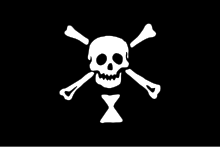Emanuel Wynn

Emanuel Wynn[a] (fl. 1700) was a French pirate of the 17th century who is often considered the first pirate to fly the Jolly Roger.
History[edit]
British Admiralty Records, in the Public Records Office in the UK show, in a report dated 18 July 1700, that HMS Poole, a 32-gun fifth-rate frigate[1] commanded by Captain John Cranby, engaged Wynn's ship off the Cape Verde islands. Cranby chased Wynn into a cove at Brava Island[b] where Wynn was able to hold out. Cranby enlisted the assistance of Portuguese soldiers, but thanks to their delay in attacking, Wynn slipped out of the harbor and escaped.[2]
Wynn's Jolly Roger Flag[edit]
Most historians agree that Cranby's journal is the first witness account of a black Jolly Roger used aboard ship,[3] which Cranby described as "a sable ensign with cross bones, a death's head, and an hour glass" (the quotation is from Earle, Pirate Wars, p. 154) or "A Sable Flag with a White Death's Head and Crossed Bones in the Fly."[4] Wynne is believed to be the first pirate to fly the now familiar form of the jolly roger.[5] His flag, showing the distinctive skull and crossbones motif, was augmented with another common pirate symbol: an hourglass, meant to signify to his prey that their time was running out and only by timely surrender could they evade death.[6] There were no other reports at the time of pirates using similar flags aboard ship (though red and other versions had been used by buccaneers during campaigns while ashore)[7] but within 15 years the skull and crossbones design and its many variants would become the standard flag of Golden Age pirates.[8]
See also[edit]
- Bartholomew Roberts, who was known to have flown not just one but several different Jolly Roger flags.
Further reading[edit]
- Fox, E. T. "Jolly Rogers: the True History of Pirate Flags."
Notes[edit]
References[edit]
- ^ "British Fifth Rate ship 'Poole' (1696)". threedecks.org. Retrieved 14 December 2018.
- ^ Earle, Peter (2005). The Pirate Wars. New York: Macmillan. pp. 153–154. ISBN 9780312335793. Retrieved 14 December 2018.
- ^ Sherry, Frank (1986). Raiders and rebels: the golden age of piracy. New York: Quill. pp. 92–93. ISBN 9780688075156. Retrieved 29 November 2017.
- ^ Grey, Charles (1933). Pirates of the eastern seas (1618-1723): a lurid page of history. London: S. Low, Marston & co., ltd. p. 17. Retrieved 26 June 2017.
- ^ Marley, David F. (2012). Daily Life of Pirates. Santa Barbara CA: ABC-CLIO. p. 181. ISBN 9780313395642. Retrieved 14 December 2018.
- ^ Pelkey, Jamin (2017). The Semiotics of X: Chiasmus, Cognition, and Extreme Body Memory. New York: Bloomsbury Publishing. p. 86. ISBN 9781474273855. Retrieved 14 December 2018.
- ^ Little, Benerson (2016). The Golden Age of Piracy: The Truth Behind Pirate Myths. New York: Skyhorse Publishing, Inc. ISBN 9781510713048. Retrieved 14 December 2018.
- ^ Kuhn, Gabriel (2009). Life Under the Jolly Roger: Reflections on Golden Age Piracy. Oakland CA: PM Press. ISBN 9781604862799. Retrieved 14 December 2018.[permanent dead link]

